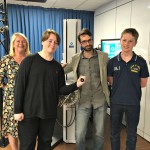Freddie and Jamie are two college students visiting BU thanks to the collaboration with the Nuffield Project.
Their aim will be to produce an epidemiological study in the Bournemouth area using the The Physical Activity Scale for the Elderly (PASE).
This is their abstract:
The Physical Activity Scale for the Elderly (PASE) questionnaire is a common means of assessing the self-reported physical activity in the elderly over a 7 day period, as it is quite simple to administer, it can be carried out in a short period of time, via interview or self-administration (such as a survey) over a large group of subjects. Due to the ease of use, it is often core founding piece of research that occurs in the vast majority of epidemiological studies that revolve around the age group of approximately 65 years and above. One of the key benefits of the scale/questionnaire is how it gives clear and concise numerical results for an individual’s results based on very few basic calculations and how the activities it refers to are on different levels. These can consist of occupational, household and leisure activities however, all have to be within the previous seven days. It also consists of light, moderate and high-intensity activities as well as strength training (Casartelli, Nicola C. 2015).
Originally, when the PASE test came about, the method for assessing its reliability was by using a test-retest system. This is where two of the same type of test are carried out, one at the start of the testing and one after a given period of time, usually between one week and seven months. The second test however, has to be carried out within a time frame long enough so that people cannot recall answers from the previous assessment, but short enough so that the amount of physical activity they do, doesn’t change substantially. In one experiment carried out, the test retest coefficient (Pearson’s) reliability was approximately 1 for both a 3-day interval, and for a 3-week interval. Thus showing the results are easily scored using reliable methods and equipment.
The PASE is a well-established and trialled questionnaire that has been used hundreds of times as an index to understand the amount of physical activity that occurs within a community (Logan et al. 2013). It is also a very small test which takes 5-15 minutes to complete (or even less) for 12 questions.
The questionnaire was also carried out in an investigation in Japan (Hagiwara, A 2008), this had a large sample of 325 elderly subjects (aged 65+). In this investigation, validity was calculated using Spearman’s Rank Correlation Coefficient PASE scores and an accelerometer. Other correlations involving grip strength, body fat percentage, and reliability in this case was tested by the test-retest method. The average in this case was 114.9 which is correlated to energy usage and other factors. The consistencies between the first questionnaire PASE scores and the second were high, in this case this version of the PASE was accepted as valid and reliable due to the correlations and consistencies acting as supporting evidence.
The PASE questionnaire is not only used for the study of healthy elderly adults, it is also utilised for other reasons such as; Does It Predict Physical Health? , Patients After Total Hip Arthroplasty (Casartelli, Nicola C.2015) and for measures in lung cancer (Granger, C. L 2015) as well as many more, showing that this test is a very well respected and used method for scoring different categories of people.
Some reports of the PASE questionnaire say that a larger sample size is needed to gather precise validity and reliability estimates (Casartelli, Nicola C. 2015) however, most resources looked at have a suitable sample size, and some suggesting/ stating that a large group of subjects are needed Amongst the PASE questionnaire, there are two other reliable self-report questionnaires such as CHAMPS and YPAS, however resources suggest the PASE is the simplest and easiest to carry out and interpret.
If you would like to help them please complete the questionnaire HERE
Their project is part of a fall prevention research. More information can be find clicking HERE
 New research shows that active gaming technology could help people with Multiple Sclerosis
New research shows that active gaming technology could help people with Multiple Sclerosis A great opportunity from the collaboration of Bournemouth University and Nuffield Foundation
A great opportunity from the collaboration of Bournemouth University and Nuffield Foundation Two-day Questionnaire Design Masterclass – Spaces still available
Two-day Questionnaire Design Masterclass – Spaces still available










 Up2U: New BU academic publication
Up2U: New BU academic publication New BU midwifery paper
New BU midwifery paper BU academic publishes in online newspaper in Nepal
BU academic publishes in online newspaper in Nepal Final day of the ESRC Festival of Social Science
Final day of the ESRC Festival of Social Science Using Art to enhance Research
Using Art to enhance Research ECR Funding Open Call: Research Culture & Community Grant – Application Deadline Friday 12 December
ECR Funding Open Call: Research Culture & Community Grant – Application Deadline Friday 12 December MSCA Postdoctoral Fellowships 2025 Call
MSCA Postdoctoral Fellowships 2025 Call ERC Advanced Grant 2025 Webinar
ERC Advanced Grant 2025 Webinar Horizon Europe Work Programme 2025 Published
Horizon Europe Work Programme 2025 Published Horizon Europe 2025 Work Programme pre-Published
Horizon Europe 2025 Work Programme pre-Published Update on UKRO services
Update on UKRO services European research project exploring use of ‘virtual twins’ to better manage metabolic associated fatty liver disease
European research project exploring use of ‘virtual twins’ to better manage metabolic associated fatty liver disease